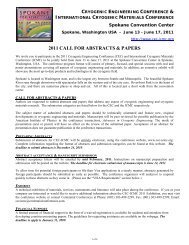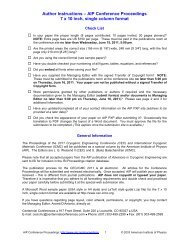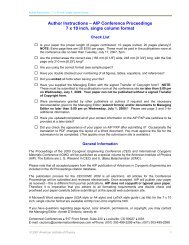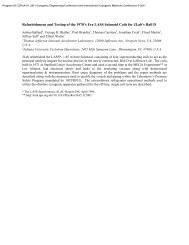CEC Abstracts in PDF format (as of 7/3/07) - CEC-ICMC 2013
CEC Abstracts in PDF format (as of 7/3/07) - CEC-ICMC 2013
CEC Abstracts in PDF format (as of 7/3/07) - CEC-ICMC 2013
You also want an ePaper? Increase the reach of your titles
YUMPU automatically turns print PDFs into web optimized ePapers that Google loves.
<strong>CEC</strong> 20<strong>07</strong> - <strong>Abstracts</strong><br />
C1-J Pumps and Compressors<br />
C1-J-01 Pressure Oscillator Losses at High Frequency<br />
and High Pressure<br />
P.E. Bradley, M.A. Lewis, R. Radebaugh, National<br />
Institute <strong>of</strong> Standards and Technology; A. Veprik,<br />
Ricor Ltd, Cryogenic Vacuum Systems.<br />
High frequencies show potential for reduc<strong>in</strong>g the size <strong>of</strong> both the<br />
pressure oscillator and cold head for a given cool<strong>in</strong>g power while<br />
lead<strong>in</strong>g to a f<strong>as</strong>ter cool-down. Previously, we made comparisons <strong>of</strong><br />
pressure oscillator efficiency employ<strong>in</strong>g a total loss method <strong>of</strong><br />
subtract<strong>in</strong>g <strong>in</strong>ternal thermodynamic losses from the PV power at the<br />
piston face for frequencies up to 70 Hz with mean pressures up to 2.5<br />
MPa for a load optimized for around 45 Hz. In this paper we present<br />
similar comparisons for high frequency operation up to 120 Hz and<br />
high mean pressure up to 3.5 MPa for an appropriately optimized<br />
load. Both small and large pressure oscillators from 4 cm3 to 25 cm3<br />
are evaluated for high frequency and high pressure operation. We<br />
discuss pressure and flow losses for the high frequency (120 Hz) and<br />
high pressure (3.5 MPa) operation compared with 30 to 60 Hz<br />
frequency and 2.0 to 2.5 MPa pressure operation. Pressure ratios<br />
ranged from 1.0 to 1.3. The overall compressor efficiency, the<br />
delivered PV power to a load divided by the electrical <strong>in</strong>put power to<br />
the compressor is determ<strong>in</strong>ed for the high frequency and high pressure<br />
operation <strong>as</strong> well.<br />
C1-J-02 Screw Compressor Characteristics for Helium<br />
Refrigeration Systems<br />
P.N. Knudsen, V. Ganni, Jefferson Lab.<br />
The oil <strong>in</strong>jected screw compressors have practically replaced all other<br />
types <strong>of</strong> compressors <strong>in</strong> modern helium refrigeration systems due to<br />
their large displacement capacity, m<strong>in</strong>imal vibration, reliability and<br />
capability <strong>of</strong> handl<strong>in</strong>g helium`s high heat <strong>of</strong> compression.<br />
At the present state <strong>of</strong> compressor system designs, half the <strong>in</strong>put<br />
energy is lost <strong>in</strong> the compression system. Therefore it is important to<br />
understand the isothermal and volumetric efficiencies <strong>of</strong> these<br />
mach<strong>in</strong>es to help properly design these compression systems. This<br />
presentation summarizes three separate tests that have been conducted<br />
on Sullair compressors at the Superconduct<strong>in</strong>g Super-Collider<br />
Laboratory (SSCL) <strong>in</strong> 1993, Howden compressors at Jefferson Lab<br />
(JLab) <strong>in</strong> 2006 and Howden compressors at the Spallation Neutron<br />
Source (SNS) <strong>in</strong> 2006. Although the compressor pressure ratio and<br />
built-<strong>in</strong> volume ratio are the primary parameters affect<strong>in</strong>g the<br />
efficiencies <strong>of</strong> the screw compressor proper, it is evident from these<br />
tests that the compressor skid design also strongly <strong>in</strong>fluences the<br />
overall efficiencies and performance <strong>of</strong> the compression system. This<br />
work is part <strong>of</strong> an ongo<strong>in</strong>g t<strong>as</strong>k at JLab to understand the theoretical<br />
b<strong>as</strong>is for these efficiencies and their loss mechanisms, <strong>as</strong> well <strong>as</strong> to<br />
implement practical solutions.<br />
C1-J-03 Design<strong>in</strong>g Liquid Cryogenic Systems for Use<br />
with Centrifugal Pumps<br />
J.E. Dillard, W.D. Batton P.E., J.A. Busby Ph.D., J.W.<br />
Shull, M.R. Anderson, Barber-Nichols Inc.<br />
A cryogenic system is a collection <strong>of</strong> <strong>in</strong>terdependent components<br />
work<strong>in</strong>g together; therefore, proper system performance is dependent<br />
upon an understand<strong>in</strong>g <strong>of</strong> each component’s relationship with other<br />
components <strong>in</strong> the system. This paper exam<strong>in</strong>es the relationship<br />
between centrifugal pumps and other components <strong>in</strong> liquid cryogenic<br />
systems dur<strong>in</strong>g cool down and steady state operation.<br />
Two common problems which affect liquid cryogenic systems are<br />
cavitation and cryogen vaporation; both can significantly decre<strong>as</strong>e<br />
m<strong>as</strong>s flow and adversely effect overall system performance. However,<br />
a system-b<strong>as</strong>ed, rather than a component-b<strong>as</strong>ed, design philosophy<br />
can help avoid these problems. Additionally, cool down and steady<br />
state operation are two equally important system modes. Excessively<br />
tight design marg<strong>in</strong>s b<strong>as</strong>ed exclusively on steady state operational<br />
requirements can compromise a system’s ability to cool itself to its<br />
operat<strong>in</strong>g temperature.<br />
C1-J-04 Experience with dry runn<strong>in</strong>g vacuum pumps <strong>in</strong><br />
helium service<br />
R. Arztmann, L<strong>in</strong>de Kryotechnik AG.<br />
A process vacuum system for helium us<strong>in</strong>g dry runn<strong>in</strong>g vacuum<br />
pumps only w<strong>as</strong> shop tested and <strong>in</strong>stalled <strong>in</strong> a refrigeration plant to<br />
serve cavities operat<strong>in</strong>g at 2K for a cryogenic storage r<strong>in</strong>g.<br />
The paper expla<strong>in</strong>s the jo<strong>in</strong>t development steps <strong>of</strong> Busch AG and<br />
L<strong>in</strong>de Kryotechnik AG to use dry runn<strong>in</strong>g vacuum pumps for helium<br />
service at ambient temperature. A roots type booster pump followed<br />
by a non lube rotary screw pump provides very good performance <strong>in</strong> a<br />
helium vacuum pump system. Variable frequency drives on both<br />
pumps allow to adjust the pump characteristics to a wide range <strong>of</strong><br />
operat<strong>in</strong>g parameters. Operation without friction <strong>of</strong> seal<strong>in</strong>g elements<br />
<strong>in</strong> the compression space also <strong>of</strong> the screw pump promises extended<br />
ma<strong>in</strong>tenance <strong>in</strong>tervals and virtually no wear on the rotors. The current<br />
plant operation at Max Plank Institute <strong>in</strong> Heidelberg, Germany<br />
Laboratory will provide additional experience for further applications.<br />
C1-J-05 Thermal Design <strong>of</strong> a Superconduct<strong>in</strong>g Bear<strong>in</strong>g<br />
with a Magnetic Journal at Room Temperature.<br />
X. Granados, Q Llober<strong>as</strong>, ICMAB-CSIC; J López, R<br />
Maynou, CEIB.<br />
Interaction between permanent magnets and superconduct<strong>in</strong>g pellets<br />
provides a stable and durable way for bear<strong>in</strong>g <strong>in</strong> both thrust and axial<br />
bear<strong>in</strong>g. The axial symmetry <strong>of</strong> the magnetic field, and that <strong>of</strong> the<br />
<strong>in</strong>ertia axis, allow achiev<strong>in</strong>g non-friction rotat<strong>in</strong>g coupl<strong>in</strong>g thus<br />
improv<strong>in</strong>g reliability and a simplification <strong>of</strong> the bear<strong>in</strong>g design. The<br />
cool<strong>in</strong>g requirement <strong>of</strong> the superconductors is a ma<strong>in</strong> concern because<br />
the life and the losses <strong>of</strong> the bear<strong>in</strong>g are essentially the life and<br />
efficiency <strong>of</strong> the cool<strong>in</strong>g system. In this work we present the thermal<br />
design <strong>of</strong> a p<strong>as</strong>sive thrust bear<strong>in</strong>g with a room temperature magnetic<br />
journal and a plane superconduct<strong>in</strong>g stator. In this paper, we discuss<br />
the ma<strong>in</strong> po<strong>in</strong>ts for optimization <strong>of</strong> the gap thermal isolation <strong>in</strong> order<br />
to achieve the m<strong>in</strong>imum losses-stiffness ratio.<br />
Tuesday, <strong>07</strong>/17/<strong>07</strong> Poster<br />
1:30pm - 3:00pm<br />
C1-K Low Temperature Superconduct<strong>in</strong>g<br />
Magnet Systems - I<br />
C1-K-01 Leak-tight weld<strong>in</strong>g experience from the<br />
Industrial <strong>as</strong>sembly <strong>of</strong> the LHC cryostats at CERN.<br />
V. Parma, N. Bourcey, P. Campos, A. Mongelluzzo, A.<br />
Poncet, CERN; P. Limon, FNAL; G. Musso, SERCO.<br />
The <strong>as</strong>sembly <strong>of</strong> the approximately 1700 LHC r<strong>in</strong>g cryostats at<br />
CERN <strong>in</strong>volved extensive weld<strong>in</strong>g <strong>of</strong> cryogenic l<strong>in</strong>es and vacuum<br />
vessels. More than 6 km <strong>of</strong> weld<strong>in</strong>g requir<strong>in</strong>g leak tightness to a rate<br />
better than 1.10-9 mbar.l.s-1 on sta<strong>in</strong>less steel and alum<strong>in</strong>ium pip<strong>in</strong>g<br />
and envelopes w<strong>as</strong> made, essentially by manual weld<strong>in</strong>g but also<br />
mak<strong>in</strong>g use <strong>of</strong> orbital weld<strong>in</strong>g mach<strong>in</strong>es. In order to ensure the<br />
fulfillment <strong>of</strong> safety regulations <strong>of</strong> pressure vessels and to comply<br />
with the leak-tightness requirements <strong>of</strong> the vacuum systems <strong>of</strong> the<br />
mach<strong>in</strong>e, welds were executed accord<strong>in</strong>g to high qualification<br />
standards and follow<strong>in</strong>g a severe quality <strong>as</strong>surance plan. Leak<br />
detection by He m<strong>as</strong>s spectrometry w<strong>as</strong> extensively used. Neon leak<br />
detection w<strong>as</strong> used successfully to locate leaks <strong>in</strong> the presence <strong>of</strong><br />
helium backgrounds. The use <strong>of</strong> SF6 <strong>as</strong> a tracer g<strong>as</strong> with a sniffer w<strong>as</strong><br />
also tried.<br />
This paper presents the quality <strong>as</strong>surance strategy adopted for welds<br />
and leak detection. It presents the statistics <strong>of</strong> non-conformities on<br />
welds and leaks detected throughout the entire production and the<br />
advances <strong>in</strong> the use <strong>of</strong> alternative leak detection methods <strong>in</strong> an<br />
<strong>in</strong>dustrial environment.<br />
Page 10 <strong>of</strong> 53






